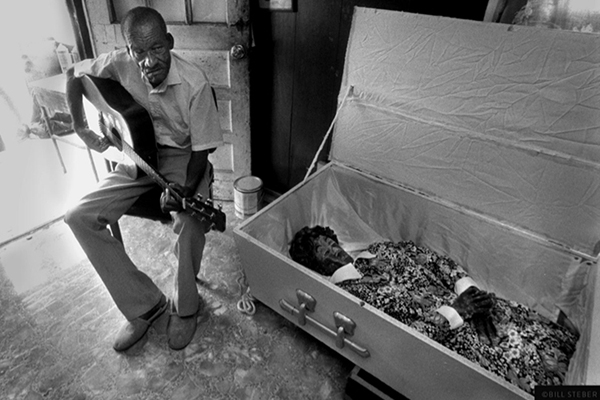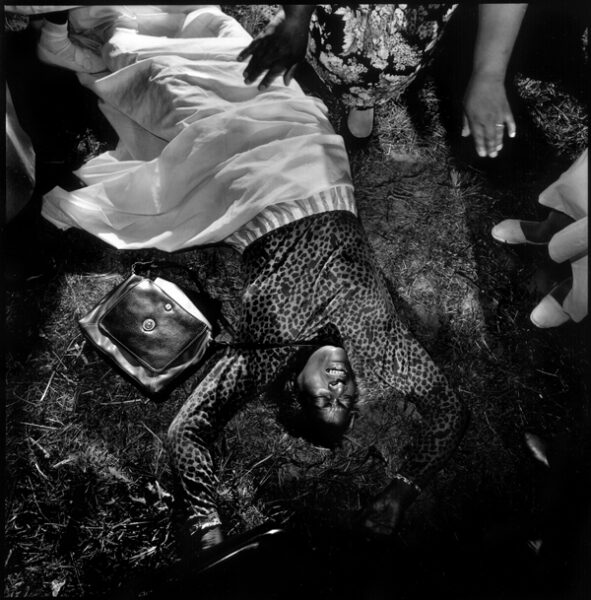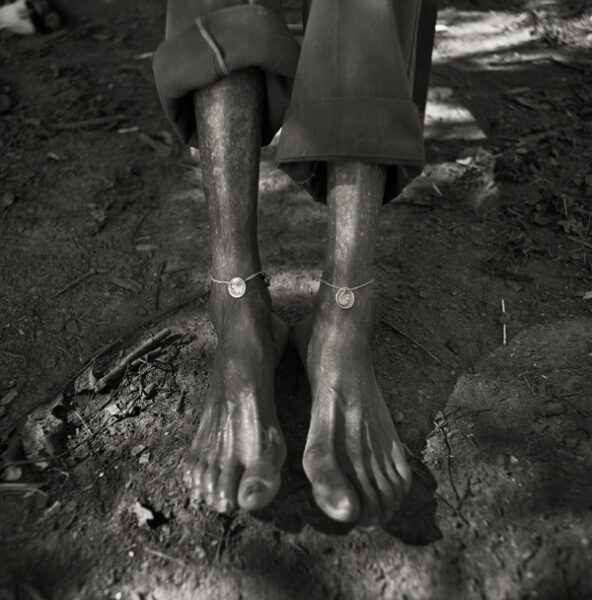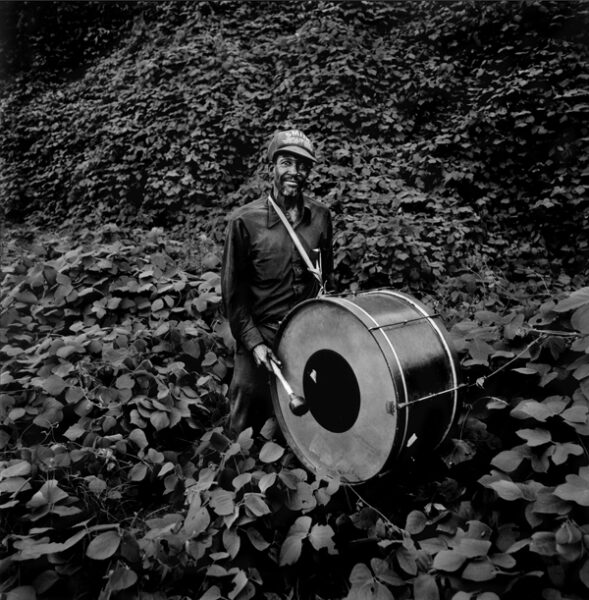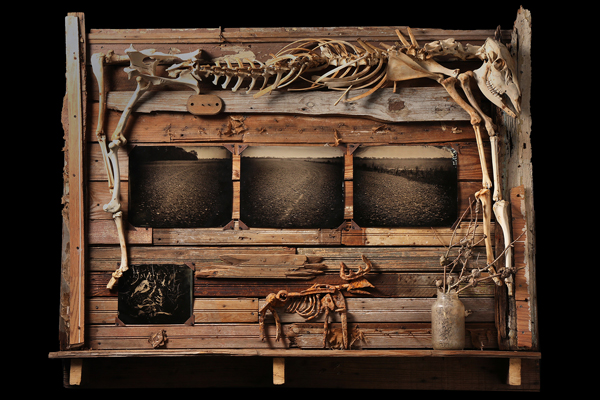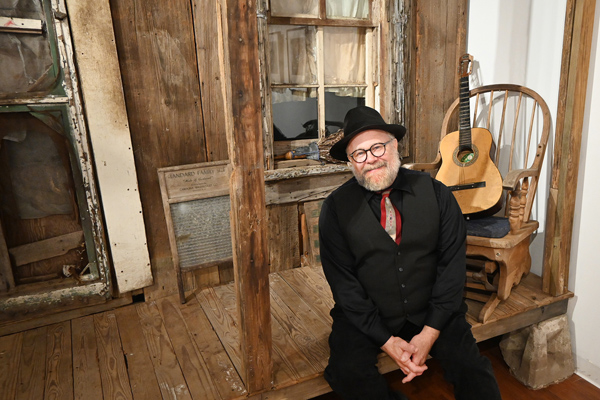
Photojournalist and Middle Tennessee State University alumnus Bill Steber takes a visual and interactive journey into the world of Delta blues with his newly installed exhibit, on display through Dec. 9 at Baldwin Photographic Gallery on the MTSU campus.
“Deep Roots: Evocations of the Mississippi Blues” features a collection of images, artifacts and mixed-media artwork from Steber’s 30-plus-year exploration and documentation of the Mississippi blues culture.
Steber will be on campus at 6 p.m. on Nov. 15 for an artist talk.
“What Bill does touches so many things—culture, history and music,” said Shannon Randol, MTSU assistant professor of photography and curator for Baldwin Gallery, located on the second floor of the Bragg Media and Entertainment Building. “He’s devoted almost his entire life to photographing one geographic location.”
Steber’s love of blues music dates to his childhood, when he discovered his parents’ record collection of crossover musicians John Lee Hooker and Jimmy Reed.
“It was kind of transformative and I became a lifelong fan of traditional blues music,” said Steber, who picked up a camera about the same time he started tinkering with music.
After graduating from MTSU, Steber was hired at The Tennessean in Nashville as a staff photographer. In 1992, he and a reporter went on assignment into the heart of the Mississippi Delta, where he met legendary musician and folk artist Son Thomas.
“It was a day that I can mark my life as ’before and after,’” Steber recalled.
In the front room of Thomas’ home in Leland, Mississippi was an “evocative” folk art sculpture of a woman’s body in a casket. Thomas performed for his guests and gave them an interview Steber will never forget.
“He was one of the most fascinating and genuine and inspiring human beings I’ve ever met, and I wanted to get as close to him and to the culture he represented [as I could],” Steber said.
But less than a year later, Thomas died from cancer.
“That set a fire under me to try to find as much of what was left of the culture that created blues in Mississippi, not just the musicians themselves, as quickly as possible,” Steber said.
His self-avowed obsession with blues and gospel culture continued deep in the Delta.
As music and dance reach a crescendo during a summer tent revival service in Clarksdale, MS, a worshipper known as “Mother Brown” is overtaken by the spirit and lies on the ground in ecstatic revelry. Such displays of faith and emotion are common in Pentecostal denominations in the South, where worshippers become overtaken, or baptized, in the Holy Spirit, often engaging in glossalalia, or speaking in tongues, as external evidence of their holy possession. Conversely, many of the church faithful in Mississippi beleive that to devote one’s life to playing the blues is to sell your soul to the devil.“I got really interested—not only in the musicians, the juke joints, the places where music happens—but the context of the people who still do traditional agriculture,” Steber said. “I started going to river baptisms. I started going to traditional services at tent revivals.”
He also sought out practitioners of hoodoo, a combination of West African religious practices mixed with herbalism and spirituality of indigenous peoples. And with that, he found other remnants of African culture still rooted in the Mississippi Delta.
“Once you learn a little bit and you learn a little bit more, the world starts opening up,” Steber said. “There’s still so much more to find. I’m still exploring to this day.”
Elvie Burg of Shaw MS wears silver dimes around her ankles. In hoodoo tradition, silver dimes are worn for good luck and as protection against malicious spells, such as goofer dust. Goofer dust is graveyard dirt that has been “activated,” often with salt peter, and is mostly used to harm the intended victim, causing sickness or even death. Goofer dust is often sprinkled in the path of the intended victim, around their bed or across the threshold of their home. If one’s path has been “dusted,” the silver dime will tarnish and turn black, indicating that someone is trying to harm them.
In addition to the gallery images, exhibit visitors will find the façade of a bona fide sharecropper shack that Steber preserved before it was demolished. Another corner of the room is an homage to Po Monkey’s juke joint in Merigold, Mississippi, including original signs and furniture from Willie “Po Monkey” Seaberry’s famous juke, as well as a scale model and images from the establishment.
Drummer Abe “Cag” Young learned drumming as a child by beating on an old gas tank in his front yard. Now in his late 60’s, Young is one of a handful of musicians in the Northeast Mississippi hill country that keep alive the centuries-old African fife and drum tradition. His father Lonnie and uncle Ed Young were among the first musicians of this music to be recorded in 1940 and 1957 by folklorist Alan Lomax for the Library of Congress. Cag Young has played for most of his musical career with fife player Otha Turner and other drummers at rural hill country picnics as well as at blues festivals in the US and Europe. Young recently retired from his job as a plantation tractor driver and is devoting more of his time to his music.
The mixed-media piece, “You May Bury My Body,” pays homage to legendary blues musician Robert Johnson. In the center of a frame fashioned from salvaged wood is a trio of tintype images of a ploughed field where once stood the Greenwood, Mississippi home in which Johnson died in 1938. There is a jar filled with dirt from the site and dead tree branches. Across the top is a reassembled deer skeleton.
“Everything here is authentic and you can smell it,” added the Baldwin Gallery’s Shannon Randol, referring to the earthen aroma of old wood and history.
MTSU’s Baldwin Photographic Gallery is located at the top of the stairwell in the interior courtyard of the Bragg Media and Entertainment Building. Off-campus visitors viewing the exhibit should obtain a special one-day permit from MTSU’s Office of Parking and Transportation at mtsu.edu/parking.
Baldwin Photographic Gallery hours are 8:30 a.m. to 4:30 p.m. on weekdays when MTSU classes are in session.
Find more on the exhibit at baldwinphotogallery.com/steberindex and see more of Steber’s work at steberphoto.com.



